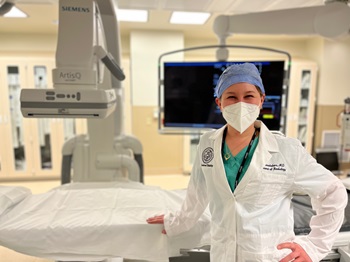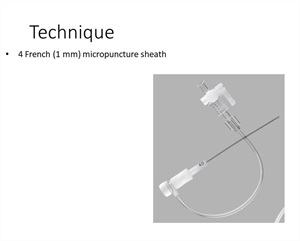To do just regular activities, things as simple as walking and sitting, it’s good to have healthy knees that are free of pain.
Chronic knee pain is known as knee osteoarthritis and is a condition in which cartilage, the natural cushioning between the joints, breaks down. The condition causes a stiffness feeling, pain, and limits any activity where you need to use your knee. The disease affects about 14 million people in the U.S. with a rapid rise over the past several decades.
“Historically we’ve always thought of knee pain or knee osteoarthritis as being a wear and tear disease but actually in learning more about it, it’s inflammation that has a lot to do with the knee pain,” explained CU Medicine interventional radiologist, Dr. Leigh Casadaban.
The inflammation then contributes to degeneration of the knee joint, causing pain. We talked with Casadaban about a new treatment to reduce that inflammation and alleviate the pain from knee osteoarthritis called genicular artery embolization.
The procedure is proving to be an effective option for patients with chronic knee pain after other common treatments such as pain medications, joint injections and physical therapy haven’t provided enough relief.
Genicular Artery Embolization
“It was first developed in Japan about five years ago and has recently come over to the U.S. and a few studies published with really, really good results,” said Casadaban.
One of those studies, out of UCLA, included 40 patients suffering with different degrees of knee pain. The study showed that after one year nearly 70% of these patients had their pain reduced by half, “They saw these results as early as one week after the procedure,” Casadaban added.
The patients in the study had tried some of the other treatments for their knee pain in the past, and either weren’t
candidates, or decided against having a knee replacement surgery. Genicular artery embolization can be a good option for those that don’t want to have surgery and want to try something minimally invasive first.
How does the procedure work?

“We believe the areas of increased blood flow that we see on imaging correspond to inflammation that’s found in the knee, that’s causing the knee pain,” Casadaban explained.
The goal of the procedure then is to treat the areas of increased blood flow to reduce inflammation and pain.
Casadaban learned, trained, and performed genicular artery embolization at UCLA before moving to Colorado. She explained that the procedure only takes a couple of hours and is outpatient, “The patient should be able to go home four hours after the procedure.”
The procedure is performed under conscious sedation. The conscious patient is able to help identify areas of pain. Markers are placed on the knee before the procedure by the interventional radiology team. Once the pain sources are identified, a small pinhole sized incision is made, usually at the crease of the leg to get into the blood vessels.
 A small catheter (a thin hollow tube) is inserted into the artery of the patient’s upper thigh. With the use of imaging and contrast dye, the
team guides the catheter into the genicular arteries that supply blood to the knee joint.
A small catheter (a thin hollow tube) is inserted into the artery of the patient’s upper thigh. With the use of imaging and contrast dye, the
team guides the catheter into the genicular arteries that supply blood to the knee joint.
“Once we get into the specific arteries that we want to treat, we place small beads. These small beads go inside the artery and plug up the blood flow to the areas of increased blood flow that are abnormal,” Casadaban said.
The device used to deliver the small particles or beads to the genicular arteries received a breakthrough device designation from the FDA in October 2021.
After the procedure patients may experience some pain or discomfort in the knee area or in the thigh where the catheter was placed and may have some temporary bruising but Casadaban said no significant post-procedure problems have been reported.
Who is genicular artery embolization for?
The ideal candidate is someone who has had long standing knee pain for at least four to six months, “With no recent injury that may have caused their pain but more of a wear and tear disease of their knee,” added Casadaban.
If the pain is interfering with your day to day life this minimally invasive option might be something good to try, especially if other treatments have failed, “We like to see that they’ve at least tried some other therapies either over the counter medications, prescription pain medications, maybe they’ve tried a joint injection, perhaps physical therapy, but we want to see that they’ve at least tried something to treat their knee pain before coming in for the procedure,” Casadaban said.
If you are interested in the procedure, it’s recommended that you go through your primary care provider for a referral. Or if your insurance allows it you may self-refer. Call the clinic consultation number for the Department of Interventional Radiology
at University of Colorado Hospital: 720-848-4479 for more information.
You will also find Dr. Casadaban at CU Medicine Interventional Radiology in
Highlands Ranch.

